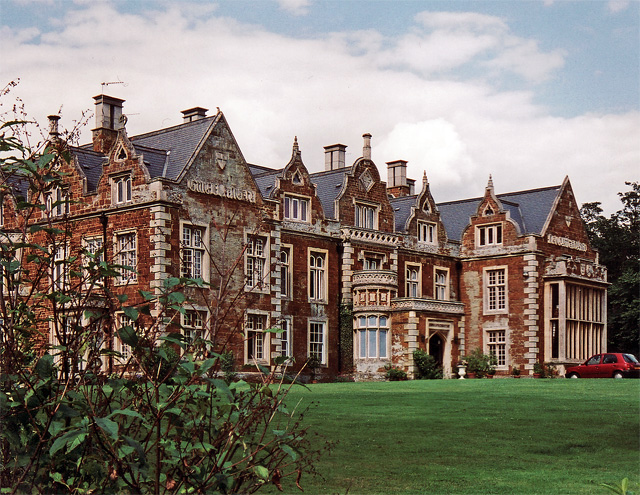Finedon Hall on:
[Wikipedia]
[Google]
[Amazon]
 Finedon Hall is a
Finedon Hall is a

 Finedon Hall is a
Finedon Hall is a Victorian
Victorian or Victorians may refer to:
19th century
* Victorian era, British history during Queen Victoria's 19th-century reign
** Victorian architecture
** Victorian house
** Victorian decorative arts
** Victorian fashion
** Victorian literatur ...
country house
image:Blenheim - Blenheim Palace - 20210417125239.jpg, 300px, Blenheim Palace - Oxfordshire
An English country house is a large house or mansion in the English countryside. Such houses were often owned by individuals who also owned a Townhou ...
in Finedon
Finedon is a town and civil parish in North Northamptonshire,
England, with a population at the 2021 census of 4,552. In 1086 when the Domesday Book was completed, Finedon (then known as Tingdene) was a large royal manor, previously held by ...
, Northamptonshire
Northamptonshire ( ; abbreviated Northants.) is a Ceremonial counties of England, ceremonial county in the East Midlands of England. It is bordered by Leicestershire, Rutland and Lincolnshire to the north, Cambridgeshire to the east, Bedfordshi ...
. It is a Grade II listed
In the United Kingdom, a listed building is a structure of particular architectural or historic interest deserving of special protection. Such buildings are placed on one of the four statutory lists maintained by Historic England in England, H ...
building.
History
The core of the house is 17th or 18th century, and was extensively remodelled by William Harcourt Isham Mackworth Dolben (1806–1872). Datestones indicate a range of different building phases: 1855, 1851, 1856 and 1859. The architect is unknown, but is likely to have been E. F. Law ofNorthampton
Northampton ( ) is a town and civil parish in Northamptonshire, England. It is the county town of Northamptonshire and the administrative centre of the Unitary authorities of England, unitary authority of West Northamptonshire. The town is sit ...
. Mackworth Dolben was himself an 'enthusiastic' amateur architect. There is also a range of fine ancillary buildings: the Museum Tower, the Bell Tower and the Old Chapel, also listed Grade II. The estate was landscaped with advice from Humphry Repton
Humphry Repton (21 April 1752 – 24 March 1818) was the last great designer of the classic phase of the English landscape garden, often regarded as the successor to Capability Brown. His style is thought of as the precursor of the more intric ...
. Until its dramatic collapse in 1951, the estate was home to the well-known monument, the Volta Tower Volta Tower was a folly in the town of Finedon, Northamptonshire, England. It was built in 1865 and collapsed in 1951.
History
The Volta Tower was built in 1865 by William Harcourt Isham Mackworth-Dolben of Finedon Hall. William Mackworth (1806— ...
.

Ownership
From the early 15th to the 18th century, the manor was in the hands of the Mulso family. On the death of the last of the Mulso line, Tanfield Mulso, Finedon passed to his daughter, Anne. She married Sir Gilbert Dolben, 1st Baronet, and the house remained in the Dolben family until the death of the last baronet, Sir John English Dolben, in 1837. It then passed to his daughter, Frances. She married William Harcourt Isham Mackworth (1806–1872), a younger son of Sir Digby Mackworth, 3rd Baronet, who took the name of Dolben. Both his heirs were drowned; the elder son William Digby Mackworth Dolben died whilst serving aboard ''HMS Volta'' in 1863 and the younger, the noted poetDigby Mackworth Dolben
Digby Augustus Stewart Mackworth Dolben (8 February 1848 – 28 June 1867) was an English poet who died young from drowning. He owes his poetic reputation to his cousin, Robert Bridges, poet laureate from 1913 to 1930, who edited a partial editi ...
, died aged seventeen while swimming in the River Welland
The River Welland is a lowland river in the east of England, some long. It drains part of the Midlands eastwards to The Wash. The river Source (river), rises in the Hothorpe Hills, at Sibbertoft in Northamptonshire, then flows generally nort ...
, near South Luffenham in Rutland
Rutland is a ceremonial county in the East Midlands of England. It borders Leicestershire to the north and west, Lincolnshire to the north-east, and Northamptonshire to the south-west. Oakham is the largest town and county town.
Rutland has a ...
in 1867. The estate passed to their sister, Ellen, after whose death in 1912 it was divided and sold.
From 1936 the hall was used by the Free French
Free France () was a resistance government
claiming to be the legitimate government of France following the dissolution of the Third French Republic, Third Republic during World War II. Led by General , Free France was established as a gover ...
as a rehabilitation centre for allied troops, and was visited on at least one occasion by Charles de Gaulle
Charles André Joseph Marie de Gaulle (22 November 18909 November 1970) was a French general and statesman who led the Free France, Free French Forces against Nazi Germany in World War II and chaired the Provisional Government of the French Re ...
. The facility was run by Col. Pierre Mallinger, who subsequently bought the hall and used it as a centre to conduct research into tropical diseases. After Mallinger's death in 1971 the hall was sold to Geoffrey St Clair Wade. St Clair Wade's scheme for developing Finedon was not realised, and by the time of his death, the condition of the house had become parlous. The hall was saved, in part, due to the efforts of the Ancient Monuments Society. The house has now been converted into apartments.
References
{{coord, 52.33777, -0.66387, format=dms, type:landmark_region:GB, display=title Grade II listed buildings in Northamptonshire Buildings and structures in Northamptonshire Towers in Northamptonshire Grade II listed houses Country houses in Northamptonshire Finedon Gardens by Humphry Repton